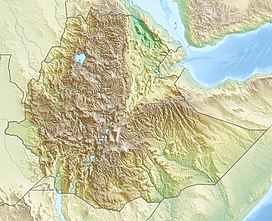279:. Trachytes and comenditic rhyolites form the main volume of the rock in the Complex. The ignimbrites have formed massive green sheets ranging in thickness from 15 cm to 25 m. The pumice deposits over the ground are common within Kone's Volcanic Complex and range in thickness from 50 cm to 20 m. Most of the pumice is found interlocked with the ignimbrites. There have been three basalt lava types identified at Kone, aphyric basalt, olivine basalt and a third basalt which contains large phenocrysts of
109:
102:
26:
308:
252:, which are part of the Wonji fault belt and ring fractures. The normal faults cause magma to rise inducing the volcanic activity. The ring fractures have caused the calderas collapse. Both of these faults have caused activity within Kone's recent history. The calderas widths can range from 1.5 to 5 km.
315:
Kone's name is a recent addition taken from a local tribal word. The historical name of Kone was
Gariboldi. Named according to local legend after an engineer who was responsible for building a road through two of the collapsed calderas. Thereby connecting
220:
phase. The most recent basalt phase is dated around 1820. This date corresponds to local legends of the eruption and the lack of vegetation growth on the lava flows provides evidence of this eruption.
408:
Acocella. V, Korme. T, Salvini. Funciello. R (2002) Elliptic calderas in the
Ethiopian Rift: control of pre-existing structures. Journal of Volcanology and Geothermal Research. 119:189–203
196:
located 30 km to the northwest, with the Boseti Gudo
Volcano further away to the southeast. Kone takes up an area of 250 square miles and has an elevation of 1619m.
291:. These different rock types provide evidence for different eruptive phases. Kone is unusual due to the number of calderas in the Volcanic Complex,
58:
101:
454:
459:
51:
150:
351:
181:
356:
241:
204:
The complex tectonic history within
Ethiopia has made the eruption history difficult to interpret from the
138:
272:
177:
245:
417:
Cole, J.W. (1969) Gariboldi
Volcanic Complex, Ethiopia. Bulletin of Volcanology. 33:566–578
378:
Cole, J.W. (1969) Gariboldi
Volcanic Complex, Ethiopia. Bulletin of Volcanology.33:566–578
255:
There are many rock types identified at Kone and they are divided into five main groups,
25:
307:
448:
205:
193:
169:
249:
209:
248:.) There are two fault lines that have caused the volcanic activity within Kone,
317:
288:
189:
346:
264:
233:
73:
60:
260:
256:
185:
321:
296:
237:
229:
173:
121:
388:
292:
280:
276:
213:
165:
143:
427:
284:
268:
217:
41:
306:
188:
the nearest town is 5 km away and the capital of
Ethiopia,
212:
four volcanic sequences of eruption can be determined. Three
192:
is situated 160 km west of Kone. The nearest volcano is
228:
Kone, also called
Gariboldi, is made up of seven nested
374:
372:
180:, which belongs to the most northern branch of the
149:
137:
132:
89:
50:
40:
35:
18:
8:
240:cinder cones. (Not to be confused with the
15:
311:Satellite image of Kone volcanic complex
333:
389:"Kone Volcano, Ethiopia - John Seach"
341:
339:
337:
7:
14:
107:
100:
24:
1:
108:
46:1,619 m (5,312 ft)
428:"Kone | Volcano World"
476:
430:. Volcano.oregonstate.edu
94:
23:
352:Global Volcanism Program
182:East African Rift Valley
357:Smithsonian Institution
242:Garibaldi Volcanic Belt
176:. It is located on the
30:caldera of Kone volcano
312:
455:Volcanoes of Ethiopia
310:
460:Calderas of Ethiopia
200:History of eruptions
74:8.80000°N 39.69167°E
208:sequence. From the
178:Main Ethiopian Rift
70: /
324:during the 1940s.
313:
295:contains only one
216:phases and then a
36:Highest point
391:. Volcanolive.com
159:
158:
79:8.80000; 39.69167
467:
439:
438:
436:
435:
424:
418:
415:
409:
406:
400:
399:
397:
396:
385:
379:
376:
367:
366:
364:
363:
343:
246:Northern America
111:
110:
104:
85:
84:
82:
81:
80:
75:
71:
68:
67:
66:
63:
28:
16:
475:
474:
470:
469:
468:
466:
465:
464:
445:
444:
443:
442:
433:
431:
426:
425:
421:
416:
412:
407:
403:
394:
392:
387:
386:
382:
377:
370:
361:
359:
345:
344:
335:
330:
305:
299:in comparison.
226:
202:
168:located in the
155:1820 ± 10 years
128:
127:
126:
125:
124:
119:
118:
117:
116:
112:
78:
76:
72:
69:
64:
61:
59:
57:
56:
31:
12:
11:
5:
473:
471:
463:
462:
457:
447:
446:
441:
440:
419:
410:
401:
380:
368:
332:
331:
329:
326:
304:
301:
225:
222:
201:
198:
157:
156:
153:
147:
146:
141:
135:
134:
130:
129:
120:
114:
113:
106:
105:
99:
98:
97:
96:
95:
92:
91:
87:
86:
54:
48:
47:
44:
38:
37:
33:
32:
29:
21:
20:
13:
10:
9:
6:
4:
3:
2:
472:
461:
458:
456:
453:
452:
450:
429:
423:
420:
414:
411:
405:
402:
390:
384:
381:
375:
373:
369:
358:
354:
353:
348:
342:
340:
338:
334:
327:
325:
323:
319:
309:
302:
300:
298:
294:
290:
286:
282:
278:
274:
270:
266:
262:
259:, comenditic
258:
253:
251:
250:normal faults
247:
243:
239:
235:
231:
223:
221:
219:
215:
211:
207:
206:stratigraphic
199:
197:
195:
194:Mount Fentale
191:
187:
183:
179:
175:
171:
170:Oromia region
167:
163:
154:
152:
151:Last eruption
148:
145:
142:
140:
139:Mountain type
136:
131:
123:
103:
93:
88:
83:
55:
53:
49:
45:
43:
39:
34:
27:
22:
17:
432:. Retrieved
422:
413:
404:
393:. Retrieved
383:
360:. Retrieved
350:
314:
254:
227:
210:stratigraphy
203:
161:
160:
318:Addis Ababa
289:plagioclase
265:ignimbrites
190:Addis Ababa
77: /
52:Coordinates
449:Categories
434:2013-11-08
395:2013-11-08
362:2012-05-01
328:References
273:inclusions
271:, syenite
234:lava flows
65:39°41′30″E
261:rhyolites
257:trachytes
186:Borchotto
90:Geography
42:Elevation
322:Djibouti
303:Renaming
297:calderas
238:basaltic
230:calderas
174:Ethiopia
144:Calderas
122:Ethiopia
62:8°48′0″N
293:Fentale
281:olivine
277:basalts
269:pumices
224:Geology
214:Silicic
166:volcano
133:Geology
347:"Kone"
285:augite
218:basalt
164:is a
287:and
275:and
236:and
162:Kone
115:Kone
19:Kone
320:to
283:,
244:in
172:of
451::
371:^
355:.
349:.
336:^
267:,
263:,
232:,
184:.
437:.
398:.
365:.
Text is available under the Creative Commons Attribution-ShareAlike License. Additional terms may apply.

